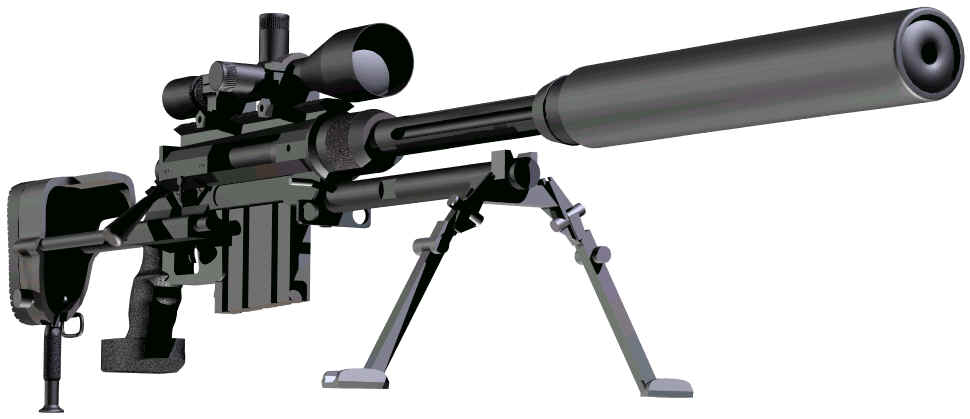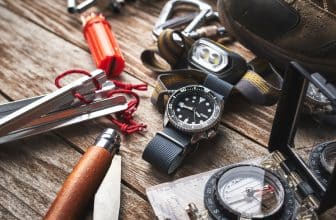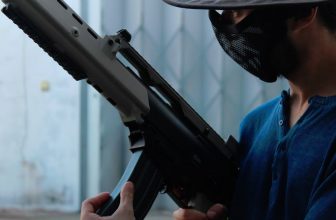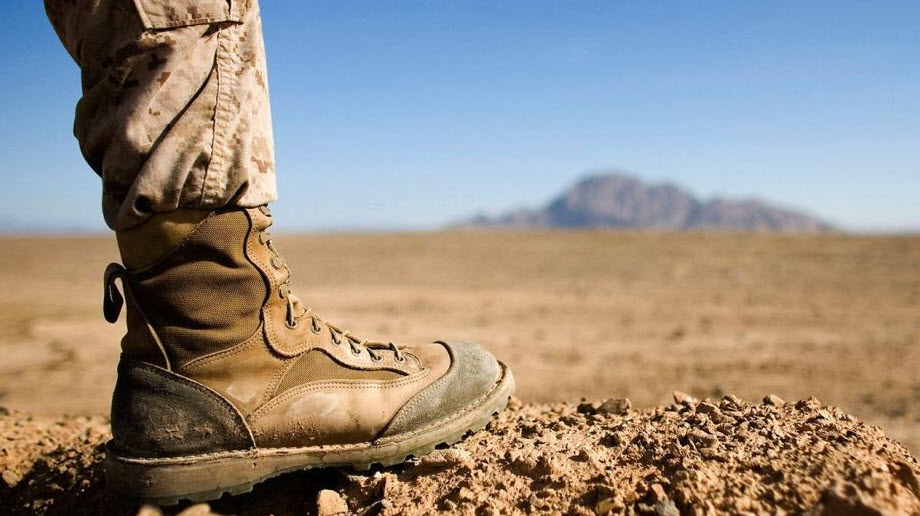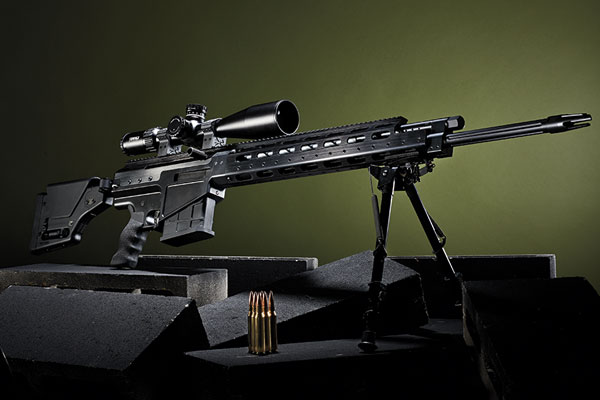
The Participants in the Development of the .338 Lapua Magnum Cartridge
It’s often cited that the originators of the .338 Lapua Magnum were James J. Bell Jr. and Boots Obermeyer. My study reveals that this is indeed true, but Edward B. Dillon and Jerry Haskins played major roles; and in all fairness, should be included in the recorded history of the cartridge.
Who are these people? Of the four, I know Bell, Dillon and Obermeyer the best. Bell and Obermeyer are probably legendary to the shooting community, while Haskins and Dillon are less known. Bell is best known for Bell Brass Extrusion Laboratories Ltd. which manufactured high quality specialty cartridge cases and eventually was sold to PMC. Bell is also know for MAST Technology, an endeavor currently assuming many of the rolls of Bell Brass Extrusion Laboratories. Obermeyer rifle barrels are considered premium to demanding shooters; but are difficult to obtain. Jerry Haskins passed away in the late 1980’s, and his name is most closely associated with Research Armament Industries that was later sold to Iver Johnson, (Jacksonville, AR.). Finally, Dillon is probably best known for Taconic Firearms Ltd. which recently introduced a new premium grade hunting rifle based on the Mauser action with a titanium receiver. The rifle is stocked with premium wood and is a beauty.
BELL
James J. Bell Jr. (Figure 1) received a BS in Engineering from Southern Illinois University. After graduation, he joined the Peace Corps and was posted to India for a period of approximately 30 months. While in India, he became friends with a number of maharajahs and returned home with over 200 of their double barrel rifles, many in out-dated calibers. Upon his return, he stopped at Holland and Holland to obtain cartridges for his new rifles, but only to learn that the cartridges were obsolete. Rechambering the rifles was out of the question so he was determined to find another way to obtain cartridges.
Bell’s parents owned Bell’s Gun & Sport Shop Inc. (Franklin Park, IL), his place of employment after returning to the States until he started making his own cartridges. He was fortunate in that David Parson was very helpful in getting him started. To manufacture cartridges, expensive machinery was necessary, but the costs were beyond the reach of this young entrepreneur so he sought a cheaper approach. First, Bell studied the Machinery Handbook for Small Arms Ammunition issued by the Frankford Arsenal in 1952 and 1953 — a task that took him approximately ten months. With this newly gained knowledge, he was able to purchase used machinery placed on the market by the government. The government listings failed to provide written descriptions, only their code numbers which Bell had previously memorized. Thus, ingenuity allowed him to purchase a number of machines over the ensuing years for a small fraction of their actual worth.
Bell’s next task was to recondition or rebuild the machines so that they were fully operational. Reconditioned machines were either used by Bell, or were sold individually or with other machines as a package. Over the years, he marketed cartridge manufacturing “packages” to a number of different companies including Winchester, Federal, Lake City etc. in this and other countries. On one of the walls at MAST Technology is a map of the world with color pins representing sites where Bell installed machinery.
In 1974, Bell’s first contract was to Holland and Holland for .500-.465 loaded cartridges. This was followed by a contract to manufacture .50 Sharps (3.25″) for Navy Arms and then the .45 Basic (3.25″) for RCBS. Later, he made other cartridge cases including the unformed .416 Rigby.
In 1989, Bell sold his business to PMC and moved to Boulder City to direct operations for them. Unfortunately the arrangement did not work; and as a result, he left. Bell felt that he was too young to retire so he started a new business in Las Vegas named MAST Technology. MAST stands for the first letter of the first name of the wives of his three new partners and his wife. With time, Bell found himself running the business alone until one of his two sons, James. J. Bell, III (aka Jay — lots of James in the Bell family) indicated that he wanted to participate in the business.
Today, Jay Bell has expanded the business into a number of new areas; and with caution, he continues to seek additional areas of promise. MAST Technology has always been known for quality cartridge cases which have been adopted by quality rifle cartridge manufacturers such as Dakota Arms, Federal Cartridge Co., Heavy Express Magnum, Lazzeroni Arms and Remington Arms.. But, MAST Technology is more than a cartridge case manufacturer. It also engage in number of specialized contracts with the government as well as the firearm industry.
DILLON
Edward B. Dillon (Figure 2) majored in physics at the University of Toronto. After leaving the University, he joined the United States Air Force — retiring with the rank of Major after 20 years of service. He flew over100 combat missions in Viet Nam as a bombardier in various B-52 aircraft and served as a weapons operator in FB-111 A aircraft. In addition he served as Emergency Actions advisor to the national command authority at NORAD.
After leaving the service, he joined Jerry Haskins at Research Armament Prototypes Industries (aka RAI) and assisted in the formation of the company, primarily as director of military sales. Subsequent responsibilities included negotiating contracts with the Department of Defense and providing instruction for weapons used by Special Forces, Navy Seals and CIA personnel. After leaving RAI, he served as director of development for Redick Arms, position which involved successfully negotiating contracts with Navy to produce tactical rifles for the SEALS.
Before going into partnership to start Taconic Firearms, Dillon served as manager of Dakota Arms, Inc (Sturgis, SD). Some of his responsibilities included supervising the development of cartridge cases for the .300 and .330 Dakota cartridges as well as recommending some design changes to the company’s line of turn-bolt rifles. With Taconic Firearms, he helped to establish a facility within Cambridge Valley Machining (Cambridge, NY). From this facility emerged premium hunting rifles based upon a titanium Mauser action stocked with premium wood. I handled one of these rifles at the 1998 SHOT Show and must admit that, not only was it deceptively light, it was beautiful. Demand has been high for these rifles, but manufacturing has been temporarily suspended.
HASKINS
Jerry Haskins (Figure 3) started a business with Doug Champlin under the name of Champlin and Haskins located in Enid, Oklahoma. The association did not last, and Haskins decided to move to Rifle, Colorado — the home of his father-in-law. His father-in-law was a machinist and ran his own machine shop. This period of Haskins life was significant for two reason: Haskins constructed two commemorative rifles for the Bi-Centennial as well as his submitting an application, and subsequently receiving a patent for a turn bolt rifle with rear locking lugs.
During the early 1980’s, Jerry Haskins decided to settle in the birthplace of his father, Rogers, Arkansas. He was successful in raising the necessary capital from the local bank to start a manufacturing firm. Political correctness was responsible for changing the original name from Research Armament Prototypes Enterprises (RAPE) to Research Armament Prototypes Industries. In the literature today, one finds another name for the firm: Research Armament Industries (RAI). RAI has seemed to stick.
In addition to the manufacturing of the Model 300, the Model 500 and the 8.58x71mm cartridge, RAI manufactured one prototype pistol in the 9mm, and was involved in the conversion of 9mm machine pistols. RAI also manufactured other interesting items that shot projectiles and probably should not be reviewed here.
OBERMEYER
Boots Obermeyer (Figure 4) grew up on a small farm outside of Racine, WI. While at Walker Ajax, Obermeyer’s father started a hardware/gunshop business with a partner. With time, his father became the superintendent for the entire plant while a second business channeled its focus on guns and fishing gear. Obermeyer matriculated to the University of Wisconsin at Racine and remained for two years. It was at this time that he realized gunsmithing was his career goal; and as a result, decided to enroll in the gunsmithing program at Trinidad Junior College in Trinidad, CO.
Obermeyer gained a high affinity for rifle barrel making via the influence of Bill Prator. At the time, Prator was department head and had a barrel shop behind his home. Obermeyer worked in the shop and eventually was treated as a member of the family. Even though Prator’s name is not well-known today, Obermeyer considers him a giant in the barrel-making field. After graduation in 1959, Obermeyer decided to start his own barrel making business. During the early stages of the business, he enlisted in the National Guard to protect his investment. Due to a mix up in the paper work, Obermeyer was drafted. He was, however, given several months to move his machines.
Much to Obermeyer’s surprise, the FBI investigated his background while he was in basic training. He found himself at the Sandia Base in New Mexico attending a school sponsored by the Department of Aeronautics and Space Administration which offered crash courses in nuclear physics and electronics. From New Mexico, he spent the next ten months in Korea and subsequently, he returned to the States to work on the Chicago Air Defense program. Turning down a commission that would have returned him to school in nuclear engineering, Obermeyer decided that not only did he want to work with his brain, but with his hands as well.
In 1969, Obermeyer met Dave Parson and became involved with Amron and the production of cartridges. His time was devoted to the manufacturing of test barrels and conducting research in Amron’s laboratories. Later Amron sold to PMC and Obermeyer worked for them as well.
Obermeyer continued to collect more equipment and manufacturing barrels became his major business. As the number of machines increased, Ruth Ann and Boots Obermeyer wanted a larger place to raise a family as well as to manufacture barrels. They moved to the current location of business in 1997 with the help of James J. Bells Jr. — known to Boots as Jimmy. With the help of a number of friends, including Ernie Stallman, the current shop was constructed.
Early in Obermeyer’s career he decided that he would operate a one-man shop because with employees, the time lost in supervision and paper work would take him away from his beloved machines. However, Ernie Stallman did work for him as a sub-contractor. In addition, his son, Eric, also worked for him before matriculating to Michigan Tech earning a research masters and now working for Marquip. The second child is Carolyn who currently is at Purdue University working on a research masters in medical chemistry.
Since the beginning, making rifle barrels has been central to his career. Obermeyer has probably either trained or given a helping hand to most of the cut rifling barrel makers at one time or another. Ernie Stallman of Badgers Barrels (Bristol, WI), Mark Chanlyn of Rocky Mountain Rifle Barrels (Boulder, CO), Jack Krieger of Krieger Barrels Inc. (Germantown, WI), Dr. Geoffrey Kolbe of Border Barrels Ltd. (Newcastleton, Scotland) and Mike Rock of Accuracy International North America (Oak Ridge, TN) are a few who have benefited from Obermeyer. In order to promote the science — as well as the art — of making rifle barrels, Obermeyer was responsible for the formation of the International Barrel Makers Association which continues to be an aid to other barrel makers and their apprentices.
Why are Obermeyer’s barrels special? One reason is the 5R rifling. With normal rifling, the transition angle between the top of the rifling land and the sidewall of the rifling groove is approximately 90 degrees. In the case of 5R rifle profile, it is approximately 55 degrees per side. If the side is extended as an imaginary line outward from the bore, they meet at 90 degrees. As a result, less deformation of the projectile occurs as it is swaged by the rifling. It has been reported that as a result of the 5R rifling, a more even pressure curve is generated as the projectile accelerates through the bore. This smoother engraving by the lands on the projectile also results in a lower stress concentration located at the corners of the rifling imprints which becomes an important factor when accelerating projectiles at high velocities through fast twist barrels, and where disintegration of the projectile downrange due to excessive centrifugal force might become a problem.
Not only is Obermeyer known for his barrel making, but he is a first-class high power rifle competitor. He has won a number of championships and is classified as high master in both match course and prone.
Boots, Ruth Ann. Willi Wordman and I were having dinner last spring when I asked the origin of the name Boots. The man wouldn’t tell me. Neither would Ruth Ann. What I did learn was that his proper name is Barrett J. The J. stands for John, his father’s first name while Barrett is his mother’s maiden name. The Barrett side of his family participated in the American Revolution while his great, great, grandfather, William Samuel Johnson, signed the Constitution.

